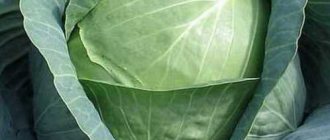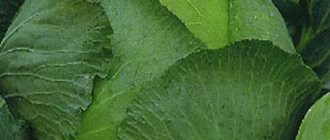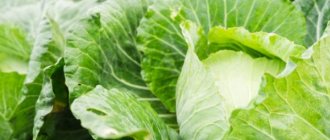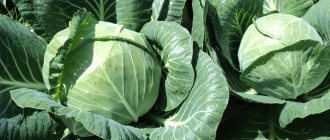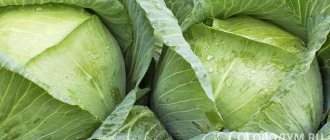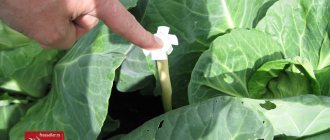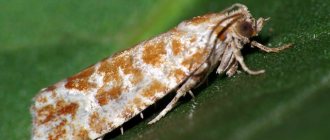Description
June cabbage is considered the most common of the early ripening varieties. High taste qualities in this culture are combined with rapid ripening. Already 60-65 days after transferring the seedlings to the garden bed, you can harvest the crop. The weight of the head of cabbage by this time reaches 1.0-2.0 kg. At the same time, the plants ripen together, which is very convenient for growing for early marketable products. Productivity is up to 6 kg per 1 sq.m.
Culture is outwardly presentable. The upper leaves are light green, and the inner cut is white-yellow. Heads of cabbage are formed in a round shape. The density of the fork is decent, considering that this is an ultra-early variety. At the same time, cabbage contains an abundance of nutrients. The vitamin C content is especially high.
Cabbage care
Early cabbage
To get a good harvest, you should properly care for cabbage.
Watering
Cabbage needs to be watered constantly, more intensively during dry periods. During ripening, you need to water less so that the heads of cabbage do not crack.
Feeding
The following should be fed with mineral and organic fertilizers:
- 1st feeding on the 20th day after planting;
- 2nd 12 days after the first;
- 3rd 12 days after the second.
A good fertilizer option is chicken manure diluted in water. It is recommended to mulch the soil around the plant with humus or compost.
Pests
Folk remedies help in pest control. It is effective to sprinkle the cabbage with crushed wood ash. The wells can be shed with a solution of colloidal sulfur before planting. If caterpillars attack, you can use special means (Iskra D, Fitoferm).
Watering with colloidal sulfur solution
Advantages and disadvantages of the variety
In addition to early ripening, the advantages of June cabbage include the resistance of this crop to cracking. Abundant watering does not harm it, but on the contrary, increases the juiciness and density of the forks. Thin, tender cabbage leaves deserve special attention. Their excellent taste is perfectly revealed in a variety of fresh spring and summer salads.
Properties of June
June cabbage is an early ripening variety. The duration of the growing season is 90-110 days. You can plant seedlings in the exhaust gas 30-45 days after the first shoots.
After transplanting the seedlings into the OG (at the beginning of May), the vegetable becomes technically mature towards the end of the third decade of June.
The leaf rosette of the plant is of a raised type, small, up to 50 cm in diameter. The leaves are light green, whole, small in size. The June leaf is characterized by the presence of slight waviness along the edges and a light waxy coating.
The heads of cabbage are uniform, very tender, and highly juicy. The shape is flat-round. The heads of cabbage are small, approximately 1.5-2.5 kg. Under favorable conditions, you can grow vegetables up to 5 kg. One of the most important advantages of June heads is the high density of “heads” (4 points). Thanks to this, the heads of cabbage are not afraid of mechanical stress and are easily transported. The taste is excellent.
Medium sized inner stump.
June high-yielding variety. From 1 hectare of plantings, 36-64 tons are collected. Converted to 1 m2, up to 7 kg of cabbage is obtained. Almost the entire harvest is suitable for sale (97%).
The variety is recommended for fresh consumption in the summer.
The variety is not protected from cracking of heads of cabbage, and is also very often damaged by cabbage fly and clubroot. In addition, it is afraid of short-term frosts (cannot withstand temperatures falling below 2 degrees Celsius.
Agricultural technology
June cabbage ripens quickly. It takes 90-110 days from the mass germination of seeds to the maturation of full-fledged forks. It must be grown using seedlings. Usually, seeds are sown for seedlings before mid-March. The seeds are buried 0.5-1.0 cm. At the end of April, the plants should have five or more true leaves. At this time they are transplanted to the garden bed.
The plant is not afraid of late spring frosts. However, it is recommended to cover the cabbage with film to protect young sprouts from cold nights and chilly winds.
Important
At first, watering must be done at least once a week. During the formation of forks, watering can be increased, if necessary. You should also fertilize the plants at least 2-3 times. For these purposes, a mixture of potassium chloride, superphosphate and ammonium nitrate is best suited.
June cabbage ripens in open ground at the end of the first month of summer. These data refer to the central zone of the Russian Federation. Southern regions, as well as Ukraine and Moldova, can enjoy ripened forks 10-20 days earlier.
Features of cultivation
Cabbage is a cold-resistant and cold-loving vegetable, so growing it for seedlings has its own characteristics compared to other vegetable crops.
Preparing for sowing
To prevent cabbage from being exposed to cruciferous diseases, the seeds must be disinfected before sowing. This procedure can be avoided if you bought seed already prepared for planting in packaging from the manufacturer.
To disinfect, the seeds are kept for 20 minutes in hot water at a temperature of 45-50 degrees. Next, they are dipped in cold water for a few minutes and dried on a napkin until crumbly.
The most reliable way is to soak the seeds in a solution of phytosporin (1 g per 1 l) for 10 hours.
Cabbage withstands transplantation well, so the seeds can be sown directly into boxes. However, if you do not need a large number of seedlings, but timing is important, it is better to sow immediately into separate cups. Then the seedlings will develop faster and can be transplanted into the ground earlier.
Important! The soil must be neutral or slightly alkaline.
The soil should be loose, breathable and fertile. To do this, it is recommended to add a little vermiculite to it.
When to plant cabbage seedlings
If containers with crops are kept in a warm room, seedlings may appear in 2-3 days. The lower the temperature, the longer germination will take.
Important! To successfully grow seedlings, boxes with seedlings after germination must be moved to a room with a temperature no higher than 10 degrees for 8-12 days.
To do this, seedlings can be placed on the balcony. If it is very cold there, you can make a small greenhouse. At this time, there is no point in keeping seedlings indoors, as they will stretch out and die.
After the specified time, the seedlings can be brought into the house. If they were planted in one box, they are picked into separate cups.
Advice! When transplanting, plants can be buried down to the cotyledon leaves.
After picking, the seedlings are kept in a room with a temperature of 18-20 degrees for several days, after which they are placed back in cool conditions. During the day, the temperature should be kept within 16 degrees, and at night no higher than 10-12 degrees.
At this temperature, cabbage seedlings will be able to develop and strengthen in order to produce a full-fledged harvest in the future.
Watch the video! June cabbage
Cabbage seedlings in protected ground
Many Russian gardeners prefer to grow cabbage seedlings directly in the beds. Sometimes greenhouses or greenhouses are used for this, but not everyone has them.
To do this, seeds that have previously been disinfected are sown in beds prepared in the fall with loose and fertile soil. This procedure is carried out from April 15 to April 30.
Before sowing, the beds are watered with hot water. The seeds are buried 1 cm at intervals of 2-4 cm from each other. Subsequently, weak shoots are carefully removed, the rest are replanted at large intervals. After sowing, arcs are installed over the bed and covered with thick non-woven material, which is pressed on all sides of the bed with stones in the ground.
With this method of growing, there is virtually no need to care for seedlings. Humidity and temperature are maintained at the required level. Rain penetrates the material and prevents the seedlings from drying out. When several true leaves appear on the seedlings, it can be thinned out. From May 1 to May 15, seedlings are planted in a permanent place without shelter. Seedlings with this method of growing grow hardened, healthy, strong, rich green in color.
Reviews
Reviews about June cabbage are most often laudatory. But with incorrect agricultural technology, this relatively unpretentious variety can cause a lot of trouble. Judge for yourself.
Olga, Vinnytsia region
I like the June one. Grows quickly and requires minimal care. But through experience, I realized that this cabbage needs a lot of light. Even the slightest shading can lead to stunted growth.
Lyudmila, Rostov
This cabbage helps us out all summer. When it ripens, we do not remove it from the garden. Poorly stored. But it stands on the ground and does not crack. Just don't need to water anymore. A very tasty variety both fresh and in borscht and casseroles. It's literally ready in a moment. Until it ripens later, we only eat it. I recommend!
Vladimir, Penza
Last year I planted June cabbage - I fell for the description. But I didn't like this variety. The heads of cabbage grew small and loose. True, it rained infrequently, but you still expect more from a good variety. And so they started eating it only in July. Although the taste is very good. But there are better early varieties, or rather hybrids.
Useful tips
Experienced vegetable growers successfully grow early varieties of cabbage, but beginners sometimes encounter difficulties, especially when it comes to seedlings. Gardeners advise:
- if the seedlings are very elongated, give them more light and reduce the temperature by 2–4°C;
- when stopping the growth of cabbage, pay attention to the level of soil moisture;
- if the lower leaves dry out for no reason, plant the bushes (they are thickened);
- if wilting occurs, but there are no other signs of disease, start loosening the soil more often (there is a lack of oxygen);
- cabbage turns yellow when it lacks iron and phosphorus or has an excess of salts;
- if you need to grow the largest heads of cabbage, shade them (cover them with burdocks, make a mesh camouflage cover to a height of 50–70 cm);
- To prevent leaves from becoming loose, spray with boric acid.
Table of varietal characteristics
| Variety or hybrid | variety |
| Ripening period | early ripening |
| Kochan | round, medium density |
| Kocheryzhka | average |
| Disease resistance | does not crack, is relatively resistant to cruciferous flea beetle and cabbage fly |
| Fruit weight, g | 1000-2400 |
| Growing areas | Ukraine, Moldova, all regions of the Russian Federation |
| Disembarkation scheme | 40-50cm x 40cm |
| From germination to ripeness | 90-100 days |
| Seed placement depth | 0.5-1.0 cm |
| Seedling age | 30-40 days |
| Soil temperature for planting seeds/seedlings | +4/+10 |
| Advantages | withstands frosts down to -5 degrees Celsius, produces yields (up to 6 kg/sq.m), is responsive to fertilizing |
| Flaws | photophilous, not intended for long-term storage, not suitable for fermentation |
Did the article help you?
How to care
June white cabbage responds positively to moisture. But just make sure that the soil is not too dry or too wet. The plant will need to be watered 2 times a week. But before harvesting, watering will have to be reduced. Approximately 10 liters of water will be needed per 1 m2.
Top dressing
As soon as 7-9 days have passed since the picking, the time has come to apply the first fertilizing. To do this, you need to prepare the following components:
- potash fertilizers – 2 g;
- superphosphate – 4 g;
- ammonium nitrate – 2 g;
- water – 1 l.
The prepared solution should be enough for 5 seedlings.
The second time it is necessary to apply fertilizer 14 days after the first. To do this, use all the same components, but only in double quantities, and the amount of water is the same. If you find that the leaves have begun to turn yellow, then you need to add fermented manure - 1:10. The third feeding involves the use of the following ingredients:
- ammonium nitrate – 3 g;
- potassium compounds – 8 g;
- superphosphate – 5 g;
- water – 1 l.
Pests and diseases
Clubroot remains the most dangerous disease for June cabbage. This disease is of fungal origin. It damages early varieties of cabbage. There is no ovary on the root system of the seedlings. To combat the disease, it is necessary to remove all affected plants with a clod of earth from the site. And sprinkle the place where the bushes grew with lime.
Next time you shouldn't grow kaputa there. Cabbage can often be affected by blackleg in the seedling stage. This is another fungal disease that attacks the root collar at the base of the stem. As a result, they become black, thin and rot. It is necessary to remove the affected plant and replace the soil on the site, since nothing else can be grown on it.
Maybe
